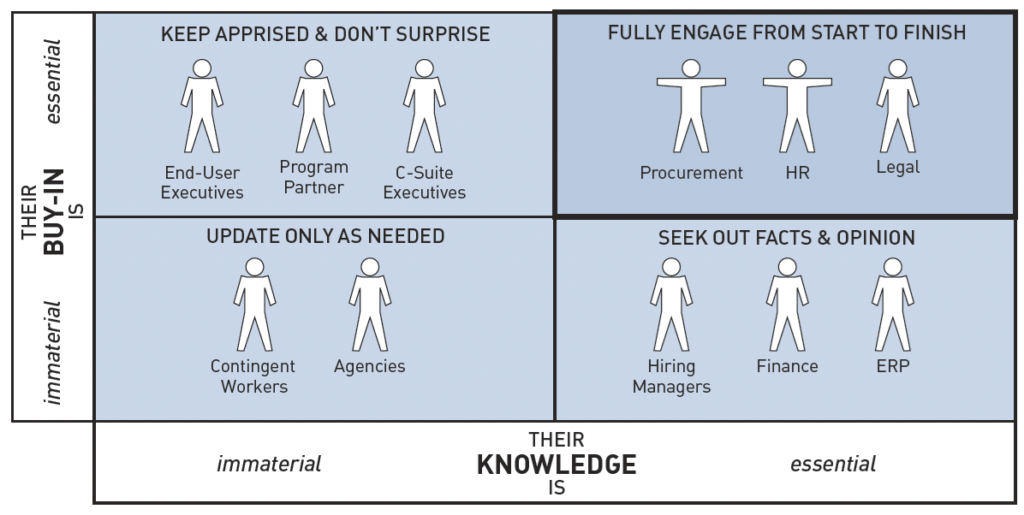Should We Outsource to a Managed Service Provider?
Blog
.

Midmarket Business Lead, North America
The contingent worker marketplace is complex. Workers have personal needs that vary significantly based upon their beliefs, individual circumstances, geographic location and skills. The marketplace is further influenced by a myriad of external forces such as political reforms, currency fluctuations, statutory mandates, and technology advancements such as AI.
So, how does an organization with limited budget and bandwidth compete against large cap organizations and governments that have seemingly unlimited resources to attract top talent in this ever-changing marketplace?
The answer is actually quite simple. First, the organization will have to gain a general understanding of the contingent worker market. Second, they will have to do an honest self-assessment of their internal resource bandwidth, budget, and capabilities. Third, they need to identify and assess their options (including outsourcing to an MSP).
In their Workforce Solutions Buyers Survey for 2019, Staffing Industry Analysts found that companies reported an average of 21% of their workforce was made up of contingent workers.
“Adoption of Managed Service Programs by companies with more 1,000 employees has grown from just over 40% in 2009 to over 60% in 2019.”
– Staffing Industry Analysts
Another key finding from this survey noted that 45% of managers spend 100% of their time on contingent workforce responsibilities-almost half of respondents!
It’s clear from the above survey that organizations are increasing their usage of contingent workers as well as looking to partner with an outsourced MSP because of the sheer workload it takes to manage a contingent workforce.
Now, more than ever, it’s important for organizations to find a partner that can help lessen this burden and navigate the changing talent landscape to ensure they as an organization are fit for the future.
Ok, but does it make sense now to outsource?
Still, one of the biggest hurdles to outsourcing may be knowing when it makes sense and how to do it successfully. Our partners at SIA have created the following matrix that provides a starting point for stakeholder discussion. The right mix depends on your organization, but we suggest starting, at a minimum, with procurement, HR, and Legal.

Once a stakeholder team has been formed, the team should seek answers to tough questions about the strategic importance of their contingent worker program as well as an honest assessment of their current state including key opportunities for improvement. The outcome of stakeholder discussions will form the basis of a business case that can be presented to executive leadership. Some baseline questions to help define business case drivers might include:
- How much do we spend each year on contingent workers?
- Is our contingent worker program a strategic priority?
- Do we have a standard process for engaging contingent workers?
- Do our current processes expose us to risk?
- Do we have a system of record for reporting?
- Are we paying too much for contingent workers?
- Is it taking too long to fill contingent requisitions?
- How do we measure quality?
- Do we have standard SLAs and metrics in place with our suppliers?
- How do we compare against competitors in our industry?
Once business case drivers have been identified and prioritized, stakeholders can begin a thoughtful self-assessment to help understand the current state. This might include a map of their current process and a RACI for each process step. Additional self-assessment considerations might include:
- Do we have the expertise to run our program in-house?
- Do we have the bandwidth to run our program in-house?
- Do we have the budget to outsource our program?
- Will we have to implement new technology to run our program?
- Who should sponsor and take ownership of our program?
- What does success look like?
After business case drivers have been identified and self-assessments have been completed, stakeholders will be in a much better position to start discussions with their leadership by being able to articulate their challenges clearly, as well as being ready to engage external partners.
Stay tuned for the next blog in this series where we’ll discuss and layout how to build a business case for an outsourced talent solution, using the above questions as a starting point.
Related Post
Pontoon hosted a roundtable discussion at SIA’s CWS Europe on the topic was Regional vs. Global MSPs. While there are clear advantages and difficult challenges to both, here are 5 ...
Similar Resources
There are lots of ways we can use data and analytics to make strategic business decisions. From cost savings to workforce reporting only covered the tip of the iceberg when ...




